Understanding Demand for Business
If your business is on a pricing plan that includes demand, learn how electricity demand could impact your energy bill and pricing plan options.

What Is Demand?
Electricity consumption, measured in kilowatt-hours (kWh), represents the amount of energy used over a given period of time.
Electricity demand, measured in kilowatts (kW), represents the rate at which electricity is used at a given point in time.
Demand is a key factor of your electricity costs and your eligibility for business pricing plans. Therefore, your business energy bill is based on the following components:
- How much electricity you use
- When you use electricity
- For some customers, how much electricity you use at any one time
Types of Demand Charges
- Non-coincident: The non-coincident demand charge is based on the higher kW demand from either the maximum monthly demand or 50% of the maximum annual demand (in any 15-minute interval). Non-coincident demand can occur at any time: day or night or during on-peak, off-peak, or super off-peak hours. The non-coincident demand charge is a component of the Utility Distribution Company (UDC) Total Rates. This charge recovers the transmission and distribution costs that SDG&E incurs to serve individual customers, such as the costs of transmission and distribution power lines and distribution substations sized to meet a customer’s load requirements.
- On-peak: The on-peak demand charge is applied to the highest kW demand (in a 15-minute interval) that occurs during on-peak time periods in the bill cycle. The on-peak demand charge periods vary by season, with summer being June 1 to October 31 and winter being November 1 to May 31. Like the non-coincident demand charge, the on-peak demand charge is a component of the UDC Total Rates. This charge recovers SDG&E’s costs for building out electric infrastructure, such as distribution substations and distribution and transmission power lines, in support of costs related to non-generation that are necessary to meet peak demand.
- Generation: The generation demand charge applies to the highest kW demand (in a 15-minute interval) that occurs during on-peak time periods, which vary by season. (Summer is June 1 to October 31, and winter is November 1 to May 31.) This charge recovers the generation costs of meeting on-peak energy demands. While the generation demand charge is similar to the on-peak demand charge, it is a component of the Electric Energy Commodity Cost (EECC). Community Choice Aggregator (CCA) customers can get details of the generation charge from their CCA.
Why Is Demand Important to Me?
Demand is important to understand because it affects your business in the following ways:
- Your eligibility for certain pricing plans. For example, if your demand goes over 20 kW, you may be moved to a pricing plan that has demand charges or different Time-of-Use periods.
- Your monthly energy bill, which is based on both the amount of energy you use and when you use it. Even if your pricing plan does not include demand charges, the basic service fee is typically linked to your demand.
How Does Demand Affect My Energy Bill?
If your pricing plan includes demand charges, then demand charges will be …
- A larger portion of your bill if you use a lot of electricity over a short period of time. (See Company A below.)
- A smaller portion of your bill if you spread out your electricity use over time. (See Company B below.)
Company A Company B
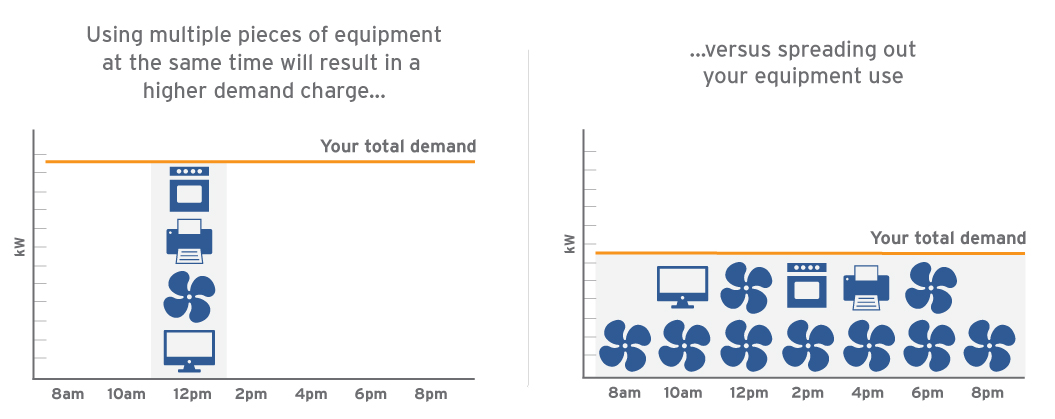
Company A is an auto repair shop that is open 30 hours a week and requires 40 kW over the course of a 120-hour month. For one hour every month, Company A requires 100 kW to start up the shop’s machines and appliances. Company A’s monthly energy use is 4,800 kWh (40 kW X 120 hours), while their maximum demand is 100 kW. Therefore, in addition to paying energy charges for using 4,800 kWh, Company A will also pay demand charges for their maximum demand of 100 kW.
Company B is a printing business that is open 40 hours a week and requires 20 kW over the course of a 160-hour month. Company B’s monthly energy use is 3,200 kWh (20 kW X 160 hours), while their maximum demand is 20 kW. Therefore, in addition to paying energy charges for using 3,200 kWh, Company B will also pay demand charges for their maximum demand of 20 kW.
Where Do I Find Demand on My Bill?
You’ll find demand displayed in two spots on your SDG&E bill.
- Check your maximum monthly demand and maximum annual demand under “Electric Usage History.” For example, the business energy bill below shows that demand reached 22.6 kW for the month and 25.1 kW for the year.
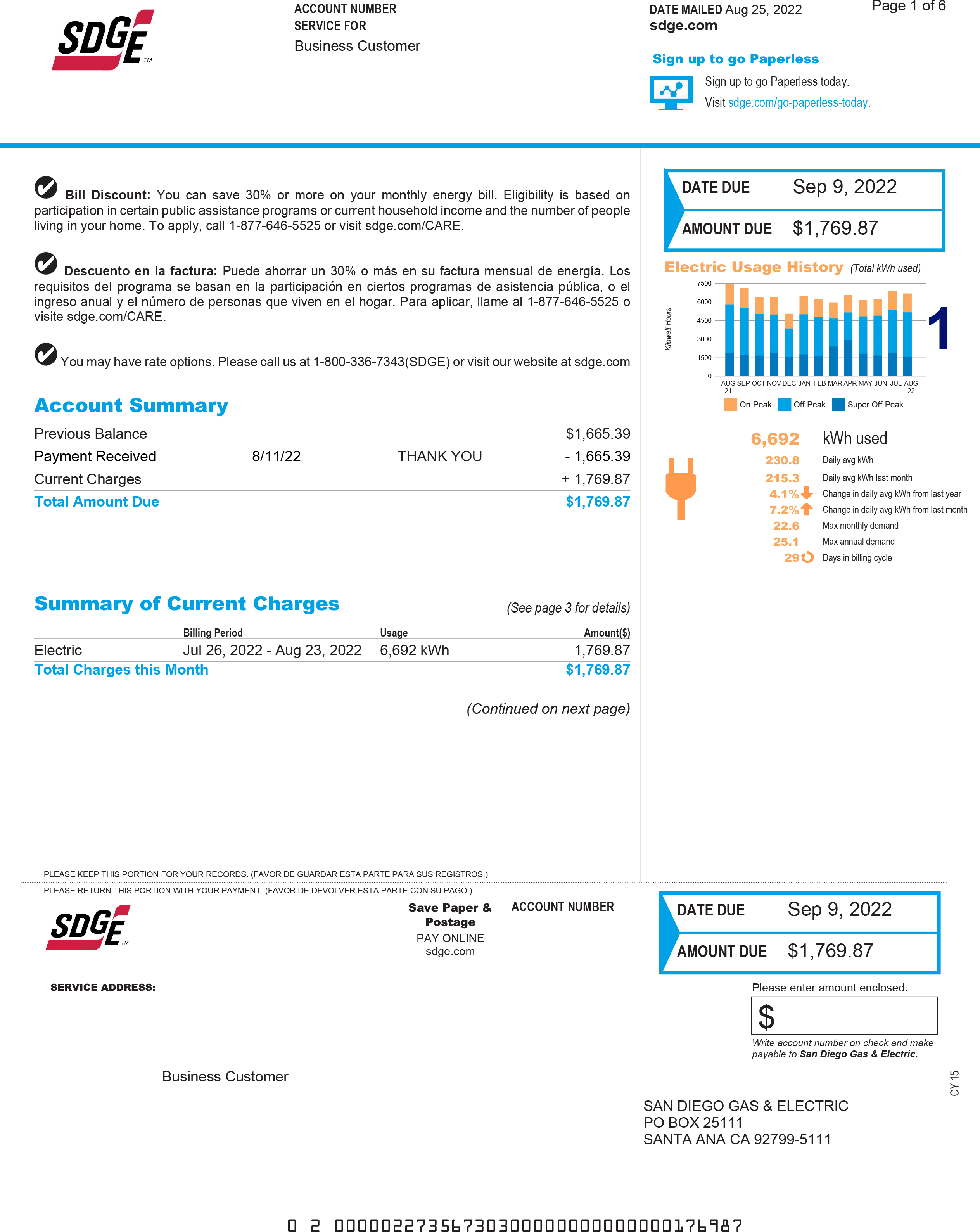
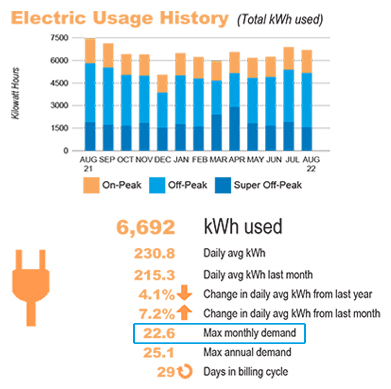
- Your maximum demand for the month also appears as the “Highest Usage Hour” under “Your Electricity Dashboard” (shown below).
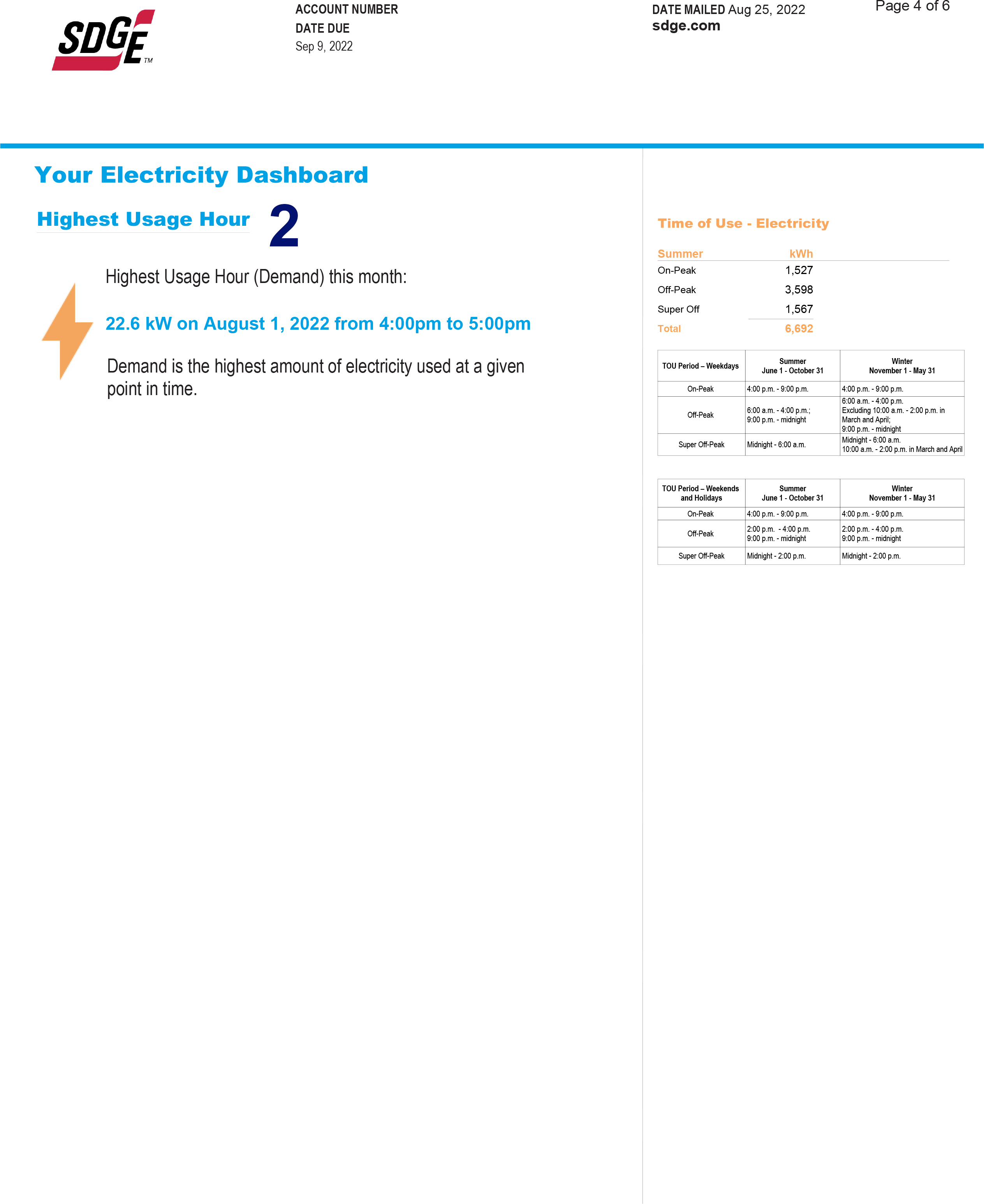
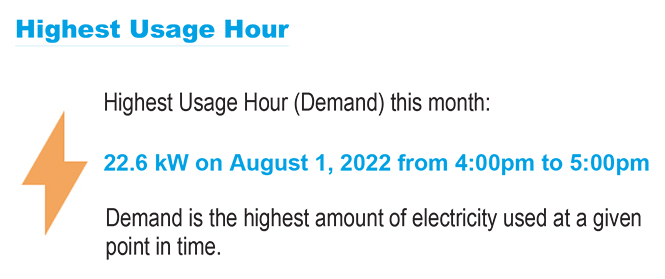
If your demand increases enough to change your pricing plan eligibility, you may be moved into a pricing plan for a larger business. To continue to be enrolled in your current pricing plan with a few adjustments to manage demand, you can remain eligible for your current plans as follows:
- If your business is on a pricing plan for small businesses (demand under 20 kW), you can stay on your current plan for another year if your demand remains under 20 kW for at least one month per year, and if your demand does not exceed 200 kW in two out of 12 consecutive months.
- If your business is on Schedule TOU-M, a pricing plan for mid-sized businesses (demand between 20 kW and 40 kW), you can stay on your current plan if you avoid three consecutive months of more than 40 kW demand.
- Track and manage your energy use information in My Energy Center so that you better understand how and when your business uses energy.
- Evaluate your operations to even out or lower demand.
- Consider shifting energy use to different time periods.
- Stagger the use of heavy equipment to eliminate spikes in demand.
- Power down electronics when your business closes for the day.
- Reduce the number of devices that you operate at the same time.
- Use equipment at a lower intensity.
- Install energy-efficient equipment to reduce overall demand. Visit our savings center for more information.
- Understand your pricing plan. Know details of your pricing plan and whether your current plan works with your business operations.
- Get personalized comparisons. When you sign into My Energy Center, review the plans available to you. It’s a good practice to regularly check plan comparisons, as changes in your demand may affect your pricing plan options.
- Review pricing plan options and find more energy-saving tips by visiting sdge.com/mybusiness.
Utility Distribution Company (UDC) Total Rates are the sum of Distribution, Transmission, Public Purpose Programs, and other charges excluding Electric Energy Commodity Cost (EECC), Department of Water Resources Bond (DWR-BC), and Wildfire Non-ByPassable (WF-NBC) charges.
Maximum monthly demand is the maximum demand during the current billing period.
Maximum annual demand is the highest maximum monthly demand for the current and prior 11 billing periods.
The maximum monthly and annual demands are both based on the highest kW demand peak in any 15-minute interval.
The EECC is the customer’s commodity rate that recovers the cost of the actual energy that SDG&E purchases, as well as the cost of generation. Community Choice Aggregation (CCA) and Direct Access (DA) customers get their EECC rate from their CCA or DA provider.
On Critical Peak Pricing (CPP) or Reduce Your Use event days, customers on event day rates do not have a generation demand charge. Instead, they can reserve capacity through the Capacity Reservation Charge (CRC) and/or pay the CPP event rates during the event
Bundled customers on event day plans do not pay generation demand charges, but they still have the same non-coincident and peak demand charges as CCA or DA customers.
The two terms are not the same. ‘Demand,’ as reflected on your energy bill, is based on the amount of energy that you use at one time. Meanwhile, ‘Demand Response’ is a set of voluntary programs that provide financial incentives to customers who can conserve energy during designated time frames in which a local or statewide power grid experiences high energy demand.





